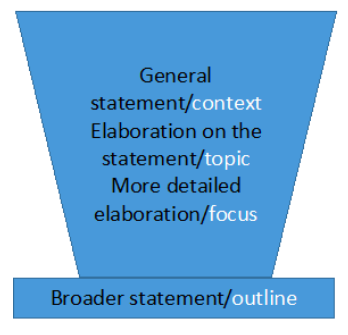Sections of a text can be many, but a document should always aspire to have the following three parts, in some form or another: an introduction, a body and a conclusion.
The Introduction
The introduction presents the topic by hooking the reader. This is done by providing context (the bigger picture, showing why it is relevant), which tends to start with some general information about the topic before moving on to the specific focus. This is where your thesis statement comes in – a question or statement which communicates to the reader what the text aims to discuss / prove / maintain. Before moving on to the body of your text, your introduction should in some way outline the structure of your text, i.e. how you will tackle the task.
The method of beginning with general information at the start and becoming more specific with each sentence, resulting in the focus of the text, is often referred to as the funnel-shaped introduction, as you can see below. This general-specific structure is not only useful in introductions; it can also be utilised at other levels: chapters, sections and paragraphs. It provides logical, structured and coherent reading for the reader.


The Body
The body is likely to contain several paragraphs in which the writer becomes more specific about the topic, elaborating main ideas, possibly in sub-sections, in other words discussing / exploring / finding an answer / response to the thesis statement. This will probably be using one, or sometimes more, of various textual patterns, e.g. cause and effect, advantage and disadvantage, and comparing and contrasting – see section Text Organisation (coming soon).
The Conclusion
The conclusion signals the end of the document and summarises the main findings / points, which should involve revisiting the thesis statement; there should be a clear link between the conclusion and introduction. No new content should be included in the conclusion and the reader should feel that the document has been brought to a ’tidy’ close.
Lastly, sections of a document need to follow a rule of unity and progression; the text must stay on topic, sections and paragraphs must be logical and organized and transitions between sections and paragraphs seamless. For more information, see Paragraphs and Coherence and Cohesion.
|
Tips: Remember, it is essential that the sections of a text:
|
| In Summary
Introduction
Body
Conclusion
|